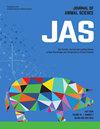The essential oil blend Agolin Ruminant L reduces methane production in vitro and in vivo when included in the drinking water of cattle.
IF 2.7
2区 农林科学
Q1 AGRICULTURE, DAIRY & ANIMAL SCIENCE
引用次数: 0
Abstract
Two experiments were conducted to determine the potential for the essential oil blend Agolin Ruminant L (Agolin) to reduce enteric methane (CH4) emissions from beef cattle when delivered via the drinking water. Experiment 1 evaluated aqueous solutions of Agolin (50 mg/L) and a non-protein nitrogen and mineral solution (uPRO ORANGE [uPRO]; 1.7 mL/L) individually and in combination, where Agolin was added to concentrated uPRO at 3, 4.5, 6% Agolin (w/w) prior to dilution with water at 1.7 mL/L, for a total of five treatments. These were incubated for 48 h with a medium-quality Rhodes grass (Chloris gayana) hay substrate, with gas production, CH4 concentration in gas, and digestibility measured in vitro. In Exp. 2, Droughtmaster steers (n = 24) were fed a basal diet of Rhodes grass hay and were allocated to one of three water treatments (n = 8/treatment) supplemented with either uPRO (2.27 mL uPRO/L water), or one of two inclusion rates of Agolin in combination with uPRO (2.27 mL uPRO and 6 µL Agolin/L water or 2.27 mL uPRO and 24 µL Agolin/L water) with enteric CH4 emissions, feed and water intake, and live weight gain (LWG) measured over 56 d. In Exp. 1, the inclusion of Agolin in uPRO at 6% w/w resulted in a reduction in CH4 production (15.8%; P = 0.003) and the proportion of CH4 in the gas produced (24.5%; P < 0.001). In Exp. 2, steers consuming the lower quantity of Agolin via drinking water had a 16.4% (P = 0.0027) reduction in CH4 production over the experiment, declining from 140 g/d during week 1 to 117 g/d in week 8. This inclusion rate of Agolin in the drinking water also resulted in a 25 g (17.6%) CH4/d decrease in emissions by steers compared to control steers (P = 0.0205). However, no significant differences in CH4 yield (g CH4/kg dry matter intake), or CH4 intensity (g CH4/kg LWG) by steers was observed between treatments. These results demonstrate that Agolin reduces CH4 emissions when mixed in aqueous solution under in vitro and in vivo conditions, providing a potential method to reduce enteric CH4 emissions from cattle in extensive production systems.将 Agolin Ruminant L 混合精油加入牛的饮用水中,可减少体外和体内甲烷的产生。
为了确定混合精油 Agolin Ruminant L(Agolin)通过饮用水减少肉牛肠道甲烷(CH4)排放的潜力,我们进行了两项实验。实验 1 评估了 Agolin(50 毫克/升)水溶液和非蛋白氮及矿物质溶液(uPRO ORANGE [uPRO];1.7 毫升/升)单独使用和混合使用的情况,其中 Agolin 被添加到浓度为 3%、4.5%、6% Agolin(w/w)的浓缩 uPRO 中,然后用 1.7 毫升/升的水稀释,共进行了五种处理。这些处理与中等质量的罗得草(Chloris gayana)干草基质一起培养 48 小时,在体外测量产气量、气体中的甲烷浓度和消化率。在实验 2 中,Droughtmaster 牛(n = 24)以罗得草干草为基础饲料,并被分配到三种水处理(n = 8/处理)中的一种,这些水处理要么添加了 uPRO(2.27 mL uPRO/L水),要么添加了与 uPRO 结合使用的 Agolin(2.27 mL uPRO 和 6 µL Agolin/L水或 2.27 mL uPRO 和 24 µL Agolin/L水)。在实验 1 中,uPRO 中添加 6% w/w 的 Agolin 可减少 CH4 的产生(15.8%;P = 0.003)和所产生气体中 CH4 的比例(24.5%;P < 0.001)。在实验 2 中,通过饮水摄入较少量 Agolin 的阉牛在实验期间的 CH4 产生量减少了 16.4% (P = 0.0027),从第 1 周的 140 克/天降至第 8 周的 117 克/天。与对照组相比,Agolin 在饮用水中的添加量也使母牛的 CH4 排放量减少了 25 克(17.6%)(P = 0.0205)。然而,在不同的处理之间,没有观察到牛的甲烷产量(克甲烷/千克干物质摄入量)或甲烷强度(克甲烷/千克LWG)有明显差异。这些结果表明,在体外和体内条件下,将 Agolin 混合在水溶液中可减少 CH4 排放,为减少粗放生产系统中牛的肠道 CH4 排放提供了一种潜在的方法。
本文章由计算机程序翻译,如有差异,请以英文原文为准。
求助全文
约1分钟内获得全文
求助全文
来源期刊

Journal of animal science
农林科学-奶制品与动物科学
CiteScore
4.80
自引率
12.10%
发文量
1589
审稿时长
3 months
期刊介绍:
The Journal of Animal Science (JAS) is the premier journal for animal science and serves as the leading source of new knowledge and perspective in this area. JAS publishes more than 500 fully reviewed research articles, invited reviews, technical notes, and letters to the editor each year.
Articles published in JAS encompass a broad range of research topics in animal production and fundamental aspects of genetics, nutrition, physiology, and preparation and utilization of animal products. Articles typically report research with beef cattle, companion animals, goats, horses, pigs, and sheep; however, studies involving other farm animals, aquatic and wildlife species, and laboratory animal species that address fundamental questions related to livestock and companion animal biology will be considered for publication.
 求助内容:
求助内容: 应助结果提醒方式:
应助结果提醒方式:


